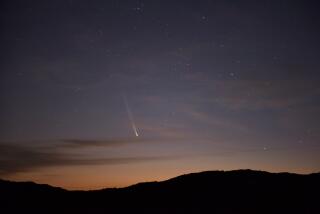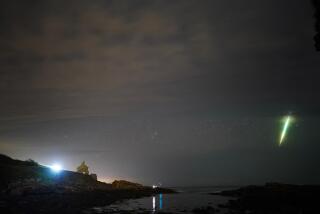Aquarius puts on a show
THE Eta Aquarids, a stream of dust particles and debris cast off by Halley’s Comet, hurtles into the Earth’s atmosphere and lights up the predawn sky through much of May. Sky watchers will be gathering in local deserts for the annual display -- so named because the meteors seem to originate from the constellation Aquarius -- which peaks on Thursday, with best visibility at 4 a.m. “A meteor shower is dust that was shed by a comet as it orbited the sun centuries ago,” says astronomer John Mosley, program supervisor of the Griffith Observatory in Griffith Park. “Younger comets have a narrow, concentrated stream of debris, while older ones have a broader, more diffuse debris field.” The longer the comet has circled the sun, the more the tail has been dispersed. As a result, younger comets yield more meteors than older ones. The Eta Aquarid shower falls somewhere in the middle, with an expected rate of 10 to 30 meteors per hour. Although the numbers seem modest, this particular display isn’t so much about quantity as it is about drama. The meteors are moving so fast that when they hit the atmosphere, they often leave long, lingering streaks of light. But seeing them, especially in the city, will require effort. Despite the waning crescent moon, the Eta Aquarids show is a challenge to amateur astronomers, says Bill Scott, president of Sidewalk Astronomers. “Because you’re looking to the southeast to see the display, even at the beach you’ll be looking directly at the city,” Scott says. “The best viewing will be out of Los Angeles, maybe toward Gorman or out in the desert near Joshua Tree.” Go to www.comets.amsmeteors.org or www.science.nasa.gov.
-- Veronique de Turenne
More to Read
Sign up for The Wild
We’ll help you find the best places to hike, bike and run, as well as the perfect silent spots for meditation and yoga.
You may occasionally receive promotional content from the Los Angeles Times.






